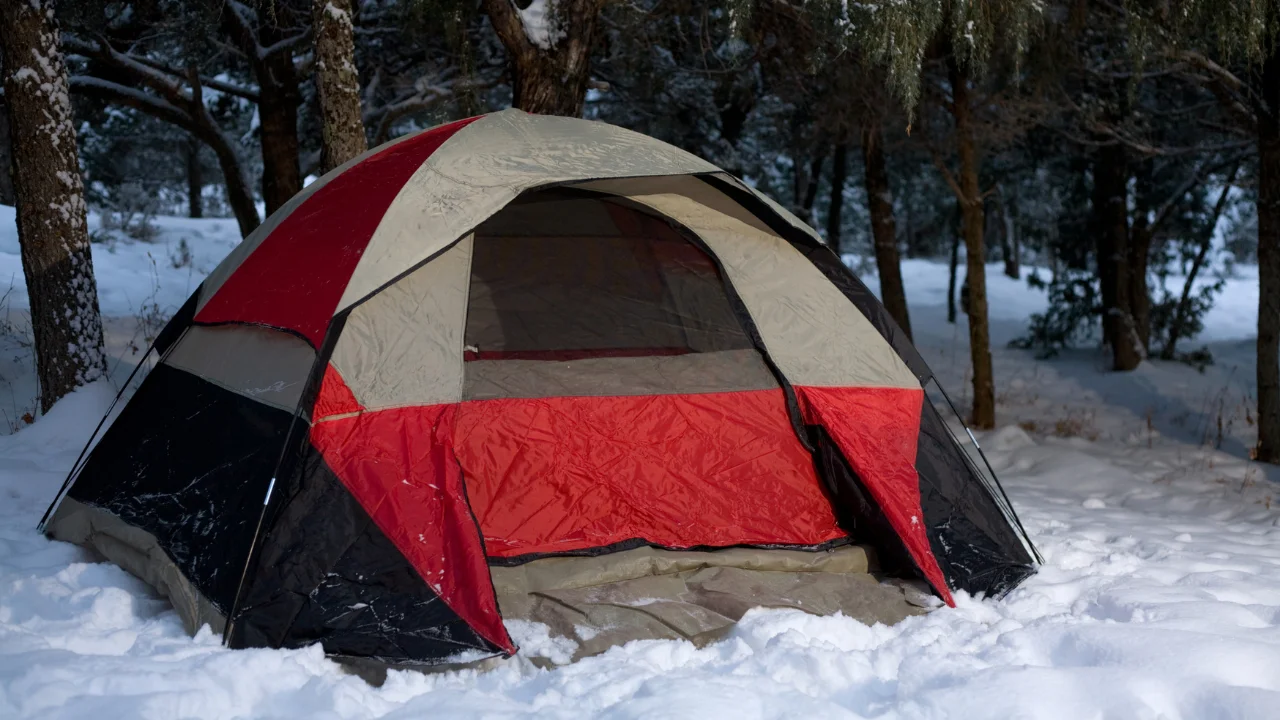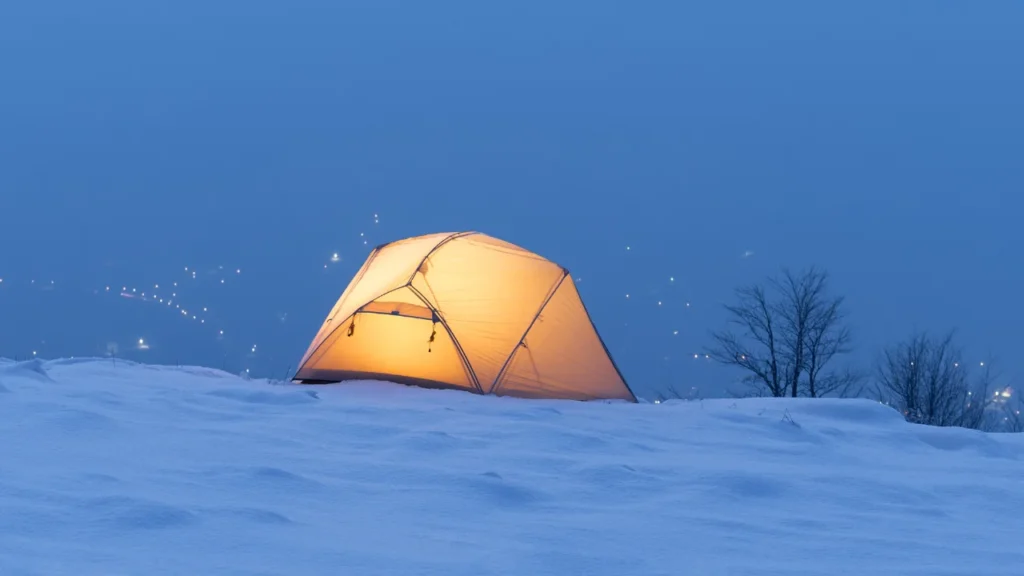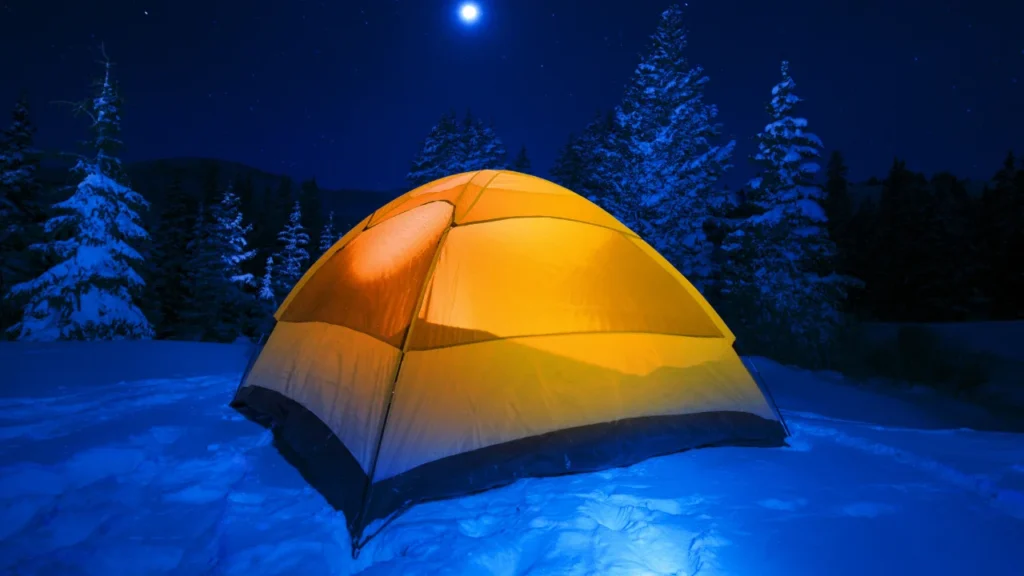
Winter Tents – Brave the Cold in Comfort
For those who love camping all year, winter camping trips offer a unique thrill. The colder months bring stunning, snowy conditions, and if you’re an avid backcountry skier or snowboarder, spending nights outside means you can hike or ski every single day without long drives. Growing up in Arizona, I rarely had the chance to experience snow camping, but after I moved to Seattle, my chances to enjoy it skyrocketed. I jumped at the opportunity to camp at Artist Point near Mt. Baker, where the solitude and beauty of winter truly stood out.
However, winter camping isn’t just about adventure—it requires the proper gear. The right winter tent is one of the most crucial pieces of gear for ensuring a well-prepared winter camping trip. Many camping enthusiasts are surprised by how challenging winter conditions can be, especially if they assume a slightly rainy night won’t turn into heavy snow. I can attest that being well-prepared makes all the difference. This article will guide you through everything that sets winter tents apart from regular tents and share top options to help you stay warm and make your winter camping trips an unforgettable experience. Thanks for reading!
What are Winter Tents?
When choosing a tent for camping, it’s important to understand the specifics of different types of tents. Tents are generally categorized based on seasons, such as one-season, three-season, or four season tents. Summer tents are specifically designed for camping in summer, being lightweight and well-ventilated to help you stay cool. However, they are not sturdy enough to handle high winds, rainstorms, or withstand heavy snow. On the other hand, three-season tents are meant for camping in spring, summer, and fall and can handle colder nights and moderate weather conditions. But if you’re heading into extreme winter conditions, you’ll need a winter tent, which is also considered a four-season tent. These tents are technically usable in every season, but they are generally warm, built to retain heat, and can take more time to set up. While they are more expensive compared to three-season tents, their sturdy construction ensures you stay safe and comfortable in rough winter conditions.
Picking the Right Winter Camping Tent
When planning a winter camping trip, choosing the right tent is key. While a three-season backpacking tent may work in mild weather, it won’t withstand strong wind or heavy snowfall. A four-season tent is stronger and built to handle extreme conditions. If the forecast shows little snow or wind, you might get by with a backpacking tent and some additional gear to stay warmer. However, an ultralight tent might not be the best choice, as they are made with the bare minimum weight and may not be sturdier for harsh winter conditions. A slightly heavier tent can provide better insulation and stability in unpredictable weather.
Difference Between a 4-Season Tent and a Winter Tent
Many people wonder if a four-season tent and a winter tent are the same, and the answer is yes. These tents are built stronger to withstand fierce winds and heavy snowfall that can completely bury a tent overnight. Unlike standard tents, they have thicker walls that help retain heat, keeping the inside warmer even in freezing temperatures. This makes them ideal for extreme weather conditions where a regular tent wouldn’t survive.
While a four-season tent is excellent for harsh environments, it is also heavier to carry due to its reinforced structure. However, this added weight provides much-needed safety, ensuring you stay alive during a severe storm or an icy night. Whether you’re climbing mountains or camping in deep snow, investing in a well-built tent can make all the difference in staying warm and protected.
Top Best Winter Tents
MSR Access 3P: A Reliable Winter Camping Tent
The MSR Access is a three-person tent designed for backcountry ski, snowboard, and snowshoe trips. It is lighter than a heavy-duty mountaineering tent, yet strong enough to protect in severe winter storms. The setup is easy with attached pole clips on the outside, allowing you to pitch it faster in the cold. Inside, it has a limited mesh to stay insulated, while the heavy-duty rainfly vents help moisture escape instead of accumulating on the tent walls. The material is ripstop nylon with XTREME Shield, a waterproof polyurethane and silicone blend. The poles are made from an advanced composite, making them durable enough not to snap in cold conditions, yet lightweight to avoid adding extra pounds to your pack. With an overall packed weight of 5lbs 1oz, the Access 3P is the second lightest winter camping tent on this list.

The North Face – VE 25
The VE 25 is a three-person tent built to withstand the worst winter storms, offering excellent durability despite its weight. Weighing in at 10lb 5oz, it is heavier than the Access 3P, but still lightweight enough for mountaineering and backcountry trips. This tent is designed to keep you prepared with fully taped seams, doors, and floors to prevent moisture from entering. The rainfly includes vestibules for gear storage and features high-strength guy lines and snow stakes to secure the tent in high winds and heavy snowfall. The ripstop nylon body has mesh vents for ventilation, while the silicone-coated ripstop nylon fly adds extra weather protection. The aluminum alloy poles provide strength while remaining lighter than traditional aluminum. Thoughtful extras include glow-in-the-dark zipper pulls, eight internal pockets, and a rainfly that allows you to set up a shelter in a storm, making it perfect for quick setups before reaching camp.
The North Face – Mountain 25
The North Face Mountain 25 is a great expedition tent that’s perfect for two people. It has the same design as the VE 25, including the tent body, rain fly, and pole materials, as well as high-strength stakes and guy lines. With glow-in-the-dark zippers, it’s easy to find your way around even at night. The tent features two doors, but the vestibule is only on one side, and it can be pitched on its own without the tent body. It also has eight internal pockets to keep your gear organized. At 9lbs 13oz, it’s slightly lighter than the VE 25. Unlike many other tents, the Mountain 25 skips the flame-retardant coating, making it a healthier tent option for those who want to avoid the carcinogen risks associated with it, while still offering safety and security for campers in case of fires. This is a safer choice for those looking to stay safe while camping, especially if you’re concerned about flame-retardant materials. Read more about this The North Face – Mountain 25
Big Agnes Copper Spur HV2 Expedition Tent
The Big Agnes Copper Spur HV2 Expedition is perfect for those who need a lightweight option for cold weather camping. While it’s a 3+ season tent, it can handle light snowfall and strong winds with ease. Designed for bikepacking and backpacking, this two-person tent offers high volume, meaning it provides more internal space for comfort. Its breathable ripstop nylon body ensures great airflow, while the high denier polyester rainfly comes with a waterproof silicone coating to handle temperature fluctuations and prevent ripping or swaying in high winds or snow accumulation. The aluminum composite poles give it the stability needed in tough conditions, and setting up is made easy with the plastic clips that attach to the tent body. Plus, the tent weighs only 5lb 5oz, making it a great choice for those who need a lightweight but reliable tent without sacrificing comfort or protection.
Black Diamond HiLight 2 Person Tent
The Black Diamond HiLight 2 Person tent is built for extreme skiing and mountaineering trips, designed to withstand harsh weather conditions. It features innovative Flow Manifold technology that draws moisture out of the tent and directs it through vents on the rainfly roof, helping to prevent moisture buildup inside. The shape of the tent, with vertical walls, not only aids in moisture mitigation but also provides extra headroom, reaching a peak height of 3.5 ft, making it more comfortable for taller campers. However, the interior space is a bit tight for two campers, and its floor space is smaller compared to other two-person tents. The tent body and rainfly are made of high-tenacity ripstop polyester, which doesn’t stretch, even in high winds, preventing the tent from flapping. With composite material poles that offer extra strength, the HiLight stands strong in tough conditions. Plus, it includes a field repair kit for any issues with the tent poles. Weighing just 3lb 15oz, it’s one of the lightest 4-season, 2-person tents, perfect for those seeking a compact yet reliable shelter.

Mountain Hardwear Trango
The Mountain Hardwear Trango is a top choice for winter camping with its impressive design. This two-person tent features D-Shaped doors, vestibules, and plenty of headroom and storage space, offering 40 square feet of interior room. It’s built with ripstop nylon and aluminum composite poles to withstand extreme conditions. Setting up is a breeze, thanks to the welded loops and clips, which easily attach to the color-coded poles. The tent also includes attachment points to secure it during a storm. Inside, you’ll find a tension shelf and a triple reinforced window that allows for ventilation and visibility. The internal mesh windows provide excellent airflow, and if you need extra light, the bright blue, bright red, and light gray color sections allow natural light to filter through. Weighing 9lb 10oz, it’s a bit heavier but still a solid option for its features. Plus, the reflective coating on guylines and stakes makes the tent easier to spot in emergencies or in the dark. Whether you’re exploring in the snow or facing tough weather, the Trango ensures a comfortable setup with plenty of visibility and easy setup even with gloved hands.
Random Tips for Winter Camping That You’ll Love
Hot Water Bottle Trick
One easy trick to keep your sleeping bag warm during cold nights is to boil some water and pour it into a bottle. Place the bottle inside your sleeping bag before you go to bed. This will help heat the bag so it’s warm when you crawl in to sleep. I personally recommend wrapping the bottle in a t-shirt to avoid it directly touching the inside of your bag, as the heat might burn or affect the fabric. This simple trick can make a big difference in how comfortable and cozy your sleeping setup is!
Battery Storage Trick
To keep your phone and camera batteries working in the cold, I like to throw them inside my sleeping bag or tuck them into one of my jacket pockets. This simple trick helps keep the batteries warm overnight and decreases the chances that the cold temperatures will suck out all the battery power. This method ensures your devices are ready to go the next day.
Add Extra Insulation Under Your Sleeping Pad
When going snow camping, it’s always smart to bring along a foam pad to place under your blow-up air pad. This foam pad acts as an excellent insulator, making it much harder for cold temperatures to get through. Think of it as a defensive layer that keeps you warmer during winter tent camping. It’s a simple and effective way to make your sleeping setup more comfortable and battle the cold more easily.
Quick Exercise Before Getting Into Your Sleeping Bag
Before you settle down for the night during snow camping, try doing some quick jumping jacks, high knees, or squats. These exercises will immediately wake up your body and help it warm up. When you get into your sleeping bag, you’ll already be generating heat, which will quickly warm up your bag, making it much more comfortable for the night. It’s a simple tip that can make a big difference in staying warm while camping in the cold.
Put Your Food in a Bear Box
When camping in winter, even though many animals are hibernating, it’s still important to secure your campsite. Make sure to store all scented items in a bear canister to avoid attracting any wildlife. Since large animals are not as active, you might be able to leave it in the middle of camp instead of hiding it like you would in the summer. However, always use your best judgment, as this can be location-dependent.
Keep your boots inside your tent
When you’re snow camping, it’s tempting to leave your boots outside your tent to avoid tracking snow into your sleeping area. However, it’s a good idea to keep your boots inside while you sleep. If you leave them outside, by the time you wake up, your shoes could be frigid and wet from dew, which is a much worse scenario to deal with in the morning. It’s always better to have your boots safe and dry inside, avoiding the possibility of them being too cold or soggy to wear when you need them most.
FAQs:
1. What temperature is too cold for camping in a tent?
For winter tent camping, temperatures below 15 degrees are generally considered too cold for comfort. However, mountaineers often deal with sub-20-degree temperatures as standard. For everyday campers, it’s important to know your limits and have the right gear if you plan on facing extreme freezing conditions.
2. Can I camp in 32-degree weather?
Yes, 32 degrees (freezing) is manageable for winter tent camping, provided you have appropriate gear. It’s not too cold for most campers and can be comfortable with the right equipment to stay warm.
3. What is the coldest temperature you can camp in?
While it varies by person and their gear, temperatures below 15 degrees can be too cold for most people unless they have specialized equipment. For mountaineers, sub-20-degree conditions are common, but these are considered extreme freezing conditions for regular campers.
4. What should I wear for cold weather camping?
When camping in cold temperatures, it’s essential to wear layers. Use thermal clothing, insulated jackets, and waterproof gear. Make sure your tent is well-ventilated but still protected from the cold, and always have a sleeping bag rated for low temperatures.
5. How can I stay warm in a tent during cold weather?
To stay warm in winter tent camping, ensure you have insulating gear, a good sleeping pad, and a sleeping bag suitable for the expected temperatures. Additionally, using a tent with good insulation and ventilation can help regulate warmth while preventing condensation.
For winter tent camping, temperatures below 15 degrees are generally considered too cold for comfort. However, mountaineers often deal with sub-20-degree temperatures as standard. For everyday campers, it’s important to know your limits and have the right gear if you plan on facing extreme freezing conditions.
Yes, 32 degrees (freezing) is manageable for winter tent camping, provided you have appropriate gear. It’s not too cold for most campers and can be comfortable with the right equipment to stay warm.
While it varies by person and their gear, temperatures below 15 degrees can be too cold for most people unless they have specialized equipment. For mountaineers, sub-20-degree conditions are common, but these are considered extreme freezing conditions for regular campers.
When camping in cold temperatures, it’s essential to wear layers. Use thermal clothing, insulated jackets, and waterproof gear. Make sure your tent is well-ventilated but still protected from the cold, and always have a sleeping bag rated for low temperatures.
To stay warm in winter tent camping, ensure you have insulating gear, a good sleeping pad, and a sleeping bag suitable for the expected temperatures. Additionally, using a tent with good insulation and ventilation can help regulate warmth while preventing condensation.
Conclusion
When it comes to winter tent camping, preparation is key to staying safe and comfortable in cold conditions. Understanding how cold is too cold for camping, having the right gear, and implementing practical tips like insulating your sleeping area, keeping your boots inside your tent, and using a bear canister for food storage are crucial steps. With the right approach, even sub-20-degree temperatures can be manageable, and the experience of camping in the snow can be incredibly rewarding. Just remember, extreme freezing conditions may not be for everyone, so always consider your comfort level and safety before venturing into the cold.



